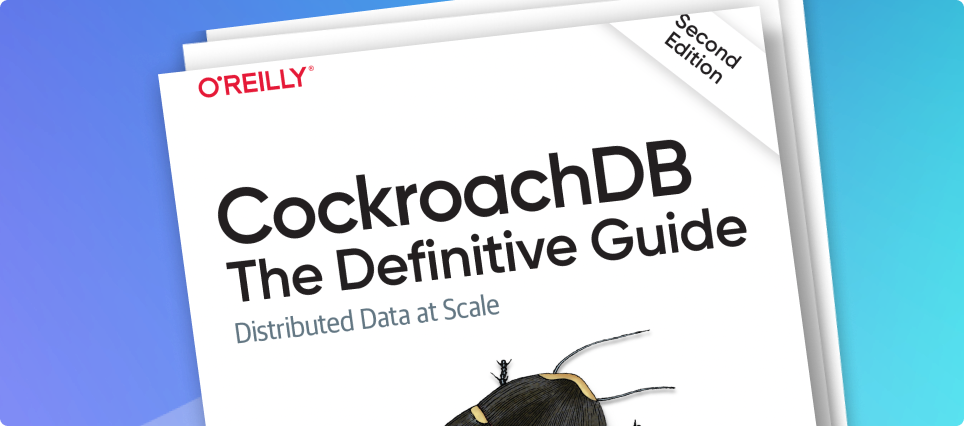As your applications scale and your user base becomes increasingly global, performance, resilience, and efficiency become more and more critical. That’s where CockroachDB shines — offering the best of traditional relational databases, wrapped in a distributed, cloud-native package. But to truly harness the power of distributed SQL, you need to tune and deploy it thoughtfully.
Here are 7 expert-backed tips from the 2nd edition of CockroachDB: The Definitive Guide (O’Reilly Media, 2025) to help you get the most out of your distributed SQL database. To get the full details, download your free copy of O’Reilly’s CockroachDB: The Definitive Guide, 2nd edition, today.
1. Design Schemas for Distribution
Don’t treat CockroachDB like a traditional monolithic RDBMS. Schema design can directly impact performance and scalability.
Design primary keys to distribute data evenly across ranges.
Use hash-sharded indexes for high-write workloads against monotonically increasing columns to reduce hotspots.
Avoid excessive joins—consider denormalization strategies like summary tables or replicated columns for read-heavy queries.
Reference: Chapter 5 - “CockroachDB Schema Design,” pp. 133-175
2. Index Like a Pro
Indexes are powerful but can add overhead so here are a few useful tips:
Use partial indexes to ensure that only data being filtered for is indexed.
Create composite indexes for multi-column filtering and sorting.
Monitor index usage and prune redundant or unused indexes regularly.
Reference: Chapter 5 - “CockroachDB Schema Design: Indexes,” pp. 156-172
3. Embrace Transaction Retries Gracefully
CockroachDB’s distributed nature means transaction retries are expected occasionally. Code defensively.
Use built-in retry logic in your language’s client libraries where available.
Reduce transaction time and avoid hot rows to limit contention.
Use
SELECT FOR UPDATEto preemptively lock rows and reduce the likelihood of retry errors.
Reference: Chapter 6 - “Application Design and Implementation: Managing Transactions,” pp. 194-206
4. Optimize SQL Execution
Understanding how queries are executed is essential to optimizing them.
Use
EXPLAIN ANALYZE (DISTSQL)to get detailed, distributed plans.Identify expensive operations like full scans or disk-based sorts.
Optimize joins using index hints or denormalization where needed.
Reference: Chapter 8 - “SQL Tuning,” pp. 265-313
5. Minimize Latency with Multi-region Optimization
To deliver ultra-low latencies to globally distributed users, take advantage of CockroachDB’s multi-region capabilities.
Use
REGIONAL BY ROWtables to pin data to a user’s region.Set survival goals (zone vs. region) based on your availability needs.
Use super regions for data sovereignty and compliance.
Reference: Chapter 11 - “Multiregion Deployment,” pp. 359-375
6. Automate Backups and Disaster Recovery
Always plan for the worst — even if CockroachDB is built with inherent resilience and to be “indestructible.”
Use scheduled backups with optional
WITH REVISION HISTORYif you need point-in-time recovery.Distribute backups across regions or clouds for durability.
Test your restore workflows regularly to validate your RTO/RPO assumptions.
Reference: Chapter 12 - “Backup and Disaster Recovery,” pp. 375-403
7. “Can it be faster?” – cluster optimization
Keep your cluster healthy by ensuring even load distribution and planning ahead:
Monitor range distribution and balance to avoid hotspots.
Use admission control to prioritize important workloads during spikes.
Monitor network latency using the Network Diagnostics page in DB Console.
Reference: Chapter 15 - “Cluster Optimization,” pp, 467-497
Ready to Optimize?
CockroachDB brings massive potential to modern applications—but tapping into its full power requires intentional design, deployment, and tuning. Whether you're building a multi-region fintech app or migrating from a legacy RDBMS, these tips will set you on the path to operational excellence.
Get your free digital copy of CockroachDB: The Definitive Guide on our website today, or pre-order the eBook or paperback on Amazon.








